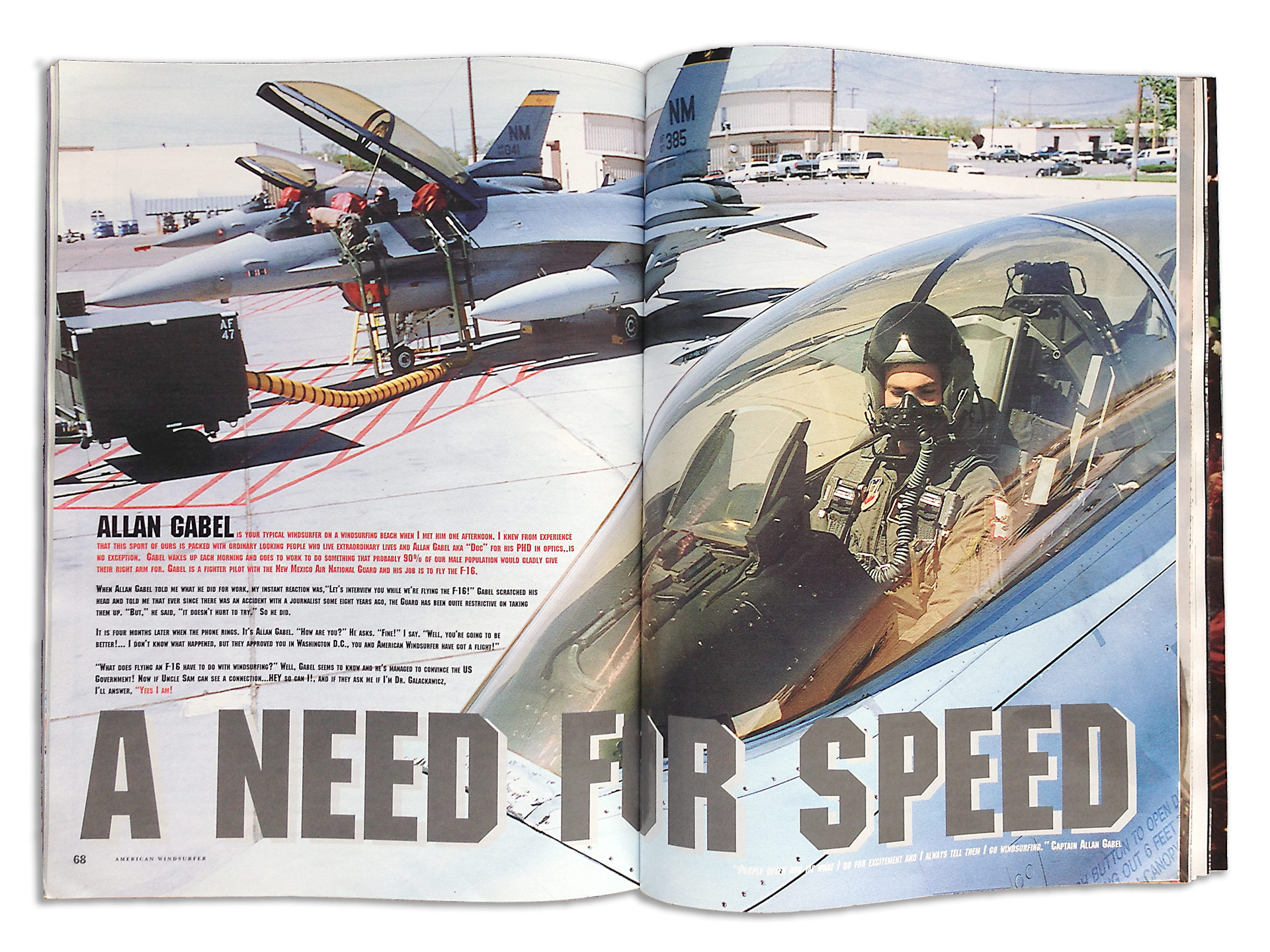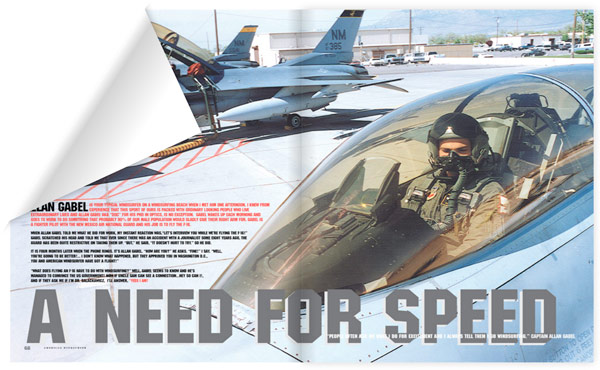
ALLAN GABEL is your typical windsurfer on a windsurfing beach when I met him one afternoon. I knew from experience that this sport of ours is packed with ordinary looking people who live extraordinary lives and Allan Gabel aka “Doc” for his PHD in optics, is no exception. Gabel wakes up each morning and goes to work to do something that probably 90% of our male population would gladly give their right arm for. Gabel is a fighter pilot with the New Mexico Air National Guard and his job is to fly the F-16.
My instant reaction was,“Let’s interview you while we’re flying the F-16!” Gabel scratched his head and told me ever since an accident with a journalist, some eight years ago, the Guard has been quite restrictive new flights. “But,” he said, “it doesn’t hurt to try.” So he did.
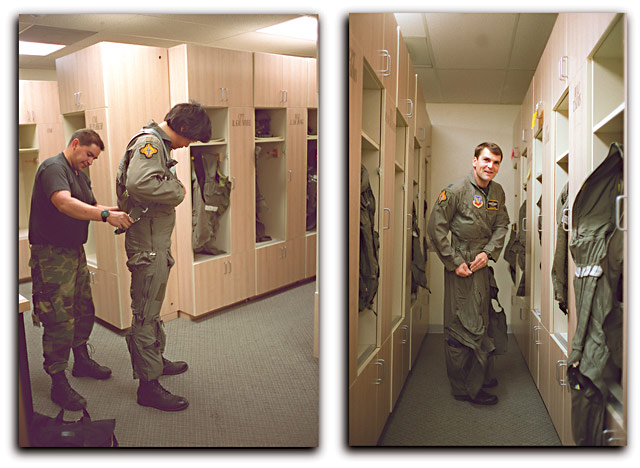
The first order of business is to get suited up with special fighter pilot gear. I am outfitted with a comfortable green flight suit and an anti-gravity suit (better known as the “G” suit) which has bladder-like pants that will inflate and deflate around my waist and legs to prevent the blood from draining from my head during high G’s. Photos by: Capt. Lon Nunley
Four months later the phone rings, it’s Allan Gabel. “How are you?” He asks. “Fine!” I say. “Well, you’re going to be better! I don’t know what happened, but they approved you in Washington D.C., you and American Windsurfer have got a flight!”
“What does flying an F-16 have to do with windsurfing?” Well, Gabel seems to know and he’s managed to convince the US Government! Now if Uncle Sam can see a connection… HEY, so can I! And, if they ask me if I’m Dr. Galackawicz, well…“Yees I am!”
Advertisement
Next, I am buckled into a parachute harness that reminds me of wearing a windsurfing seat and chest harness at the same time. The only difference is that instead of being connected to a boom and sail, I will be strapped into an ejection seat which contains a parachute and survival kit. Finally, a surprisingly light and flexible helmet is pulled down around my ears. The attached oxygen mask with a built-in microphone dangles around my chin.
DATELINE: Albuquerque, New Mexico. I am here to fulfill a dream. I have no idea what this experience will hold, yet I can already visualize it in the pages of American Windsurfer. I want to bring the readers along on an experience that hasn’t been widely available to journalists for more than eight years! Allan Gabel has gotten clearance to record the flight procedures and our conversations about flying and windsurfing during this experience. I am cleared through the gates of the base and the adventure begins…
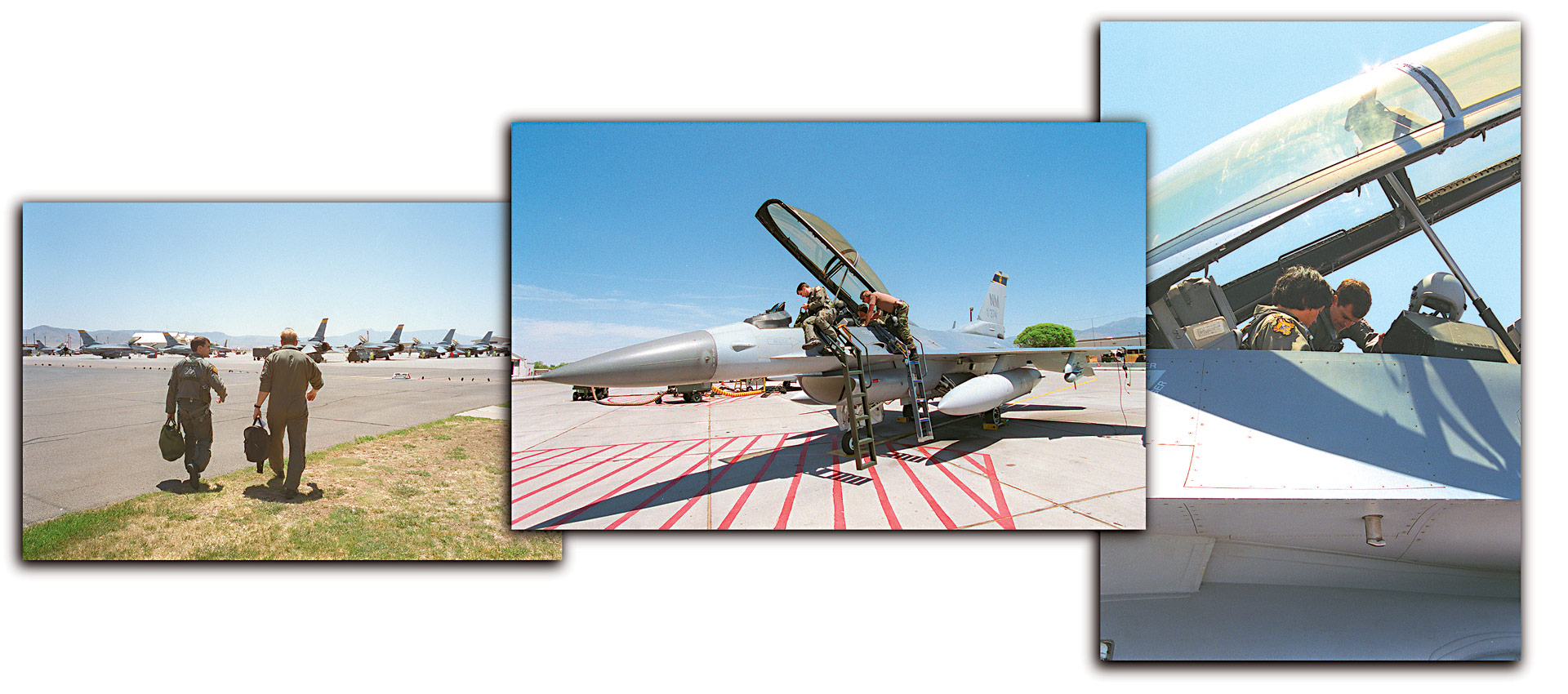
The life support department directs me through “Egress” training after I’ve suited up and I am given instructions on the ejection seat, parachute handling and proper procedures to get in and out of the cockpit. Once the procedure is complete, a flight briefing commences and the pilot goes over the flight plans, visualizing every aspect of the flight. A quick stop for a physical assessment and a sign off by the flight surgeon and we’re on our way to the jet.
On the flight line, the crew chief helps me into the back seat where everything necessary to fly the plane is duplicated. Then the pilot climbs in and the crew chief straps him in. The two ladders are removed and the pilot turns on the aircraft battery and checks some electrical circuits. The canopy closes and for a brief moment, we are shrouded in silence. The pilot fires the JFS (Jet Fuel Starter,) a small turbine starter motor, that in turn starts to turn the aircraft engine and the silence is broken. The engine runs up to 20% rpm, is engaged, and lighted. Once the engine ignites and is up to speed the generators come on line and the instrument panel comes to life as everything in the F-16 is electronically controlled. We prepare for the next critical procedure, which is to fire up the EPU (Emergency Power Unit). This unit is the most important back up system on the plane, if the plane loses its electrical or hydraulic power and the EPU does not engage, a statically unstable airplane like the F-16 will tumble and may destroy itself. To instantly fire up the EPU in an emergency situation, an extremely volatile and toxic hydrazine fuel is used. So special care is used to arm the EPU, as inhaling the hydrazine fumes would likely kill you…
Advertisement
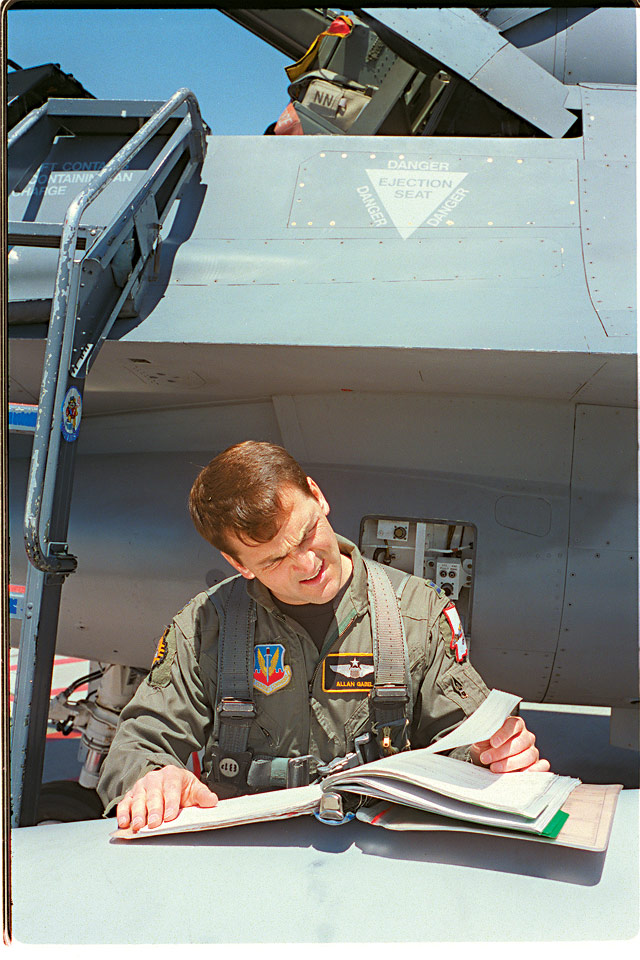
Allan “Doc” Gabel: Clear to pull the EPU pin.
CREW CHIEF: Roger, pin is pulled, you are clear to run it up.
AG: Ok rpm is coming up, John, turn your oxygen to 100 percent.
American Windsurfer: Roger. Oxygen 100.
[Pilot runs the engine up to 80%]
AG: Ok I’m turning on the EPU…sounds like it’s running pretty steady… Ok, you can turn your oxygen back to normal.
THRILL OF A LIFETIME: A two hour flight in New Mexico to interview and check out the wind at four different windsurfing locations. Allan Gabel inspects the aircraft maintenance log on the left wing tank before climbing in.
AW: Oxygen back to normal.
AG: Are we clear for FLCS check? [Flight Control System, pronounced Flickus]
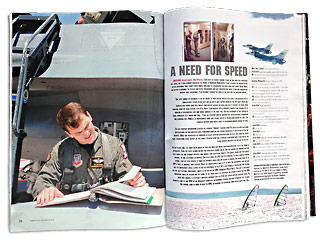
CREW CHIEF: Roger, clear FLCS.
[Crew Chief steps out of the way and the plane goes into a self-test of the ailerons, rudder and other control surfaces]
AG: Ok, check is good. Looking for no motion.
[This procedure checks the proper operation of the trim which fine tunes the flight controls.]
CREW CHIEF: No motion.
AG: Ok, left roll.
CREW CHIEF: Left up.
AG: Right roll.
CREW CHIEF: Right up…nose up…nose down…left, right.
AG: Ok, and the speed brakes.
CREW CHIEF: Clear…brakes are open and clear closed.
AG: Ok, closing speed breeeak…and flight controls.
[Pilot tests flight controls manually with stick.]
CREW CHIEF: Clear..left, right, up down.
AG: John, I’d like you to grab your stick and pull it full aft. If you look back you can see the elevator come up. Now pull up and hold it. I’m going to cut you off. That’s good, release the handles and ready to do the wheel brakes.
CREW CHIEF: Ready on the left, pumping, no movement, pumping, no movement…. ready on the right, pumping, no movement, pumping, no movement. Are you happy?
AG: Everything looks good up here.
CREW CHIEF: Ok, have a good trip.
AG: Thank you very much.
CREW CHIEF: Don’t make him sick!
AW: [Nervous Laugh]
AG: Nah, I wouldn’t do that!
AG: OK! all I need to do now is wait for the INS to get set and call up clearance…
[The INS (Inertial Navigation System) is a complex platform of sensors and gyros that tracks and reports the motion of the aircraft.]
AW: When do we arm the ejection seat?
AG: We’ll do it when we take the runway.
AG: Clearance delivery, Taco 4 zero ready copy.
CLEARANCE DELIVERY: Taco 4 zero is cleared… uh…Albuquerque 239 at 43 direct maintain niner thousand expect one six thousand in five minutes after you depart. Deeeparture is going to be on 316.7 squawk 4260.
AG: 4260 copy the rest, Taco 4 zero.
CLEARANCE DELIVERY: Bye bye.
AG: Ok, we’re ready to go!
AW: Alright!
AG: Test brakes, test steering— ready to go!
[Pilot taxis just outside the ramp and pulls up to a spot with three other ground crew who will do a final inspection.]
AW: So where are we now?
AG: We’re in Last Chance. They want to see our hands to make sure we’re not pushing any buttons while they are under the plane. They’re checking our tires, panels, and looking for leaks.
AW: Looks like we’re ready?
AG: Yeah, stand by, here’s the secondary, running up, all looks good.
[Pilot turns on ATIS (Automated Terminal Information Service) to be briefed on the airfield conditions.]
ATIS: …check density altitude, wind two seven zero at five altimeter 2 niner 88 Landing and departing on runway one 7 advise you have, Foxtrot… Albuquerque information Foxtrot 1750 zulu weather, clear, visibility more than 10. Temperature 73 dewpoint 21 check density altitude…
AG: Albuquerque ground, Taco 4 zero taxi single with Foxtrot.
GROUND CONTROL: Taco 4 zero, Albuquerque ground, runway one 7 taxi via taxiway Alpha and Bravo hold short of runway one 7 on Bravo.
AG: Holding short of one 7 on Bravo, Taco 4 zero.
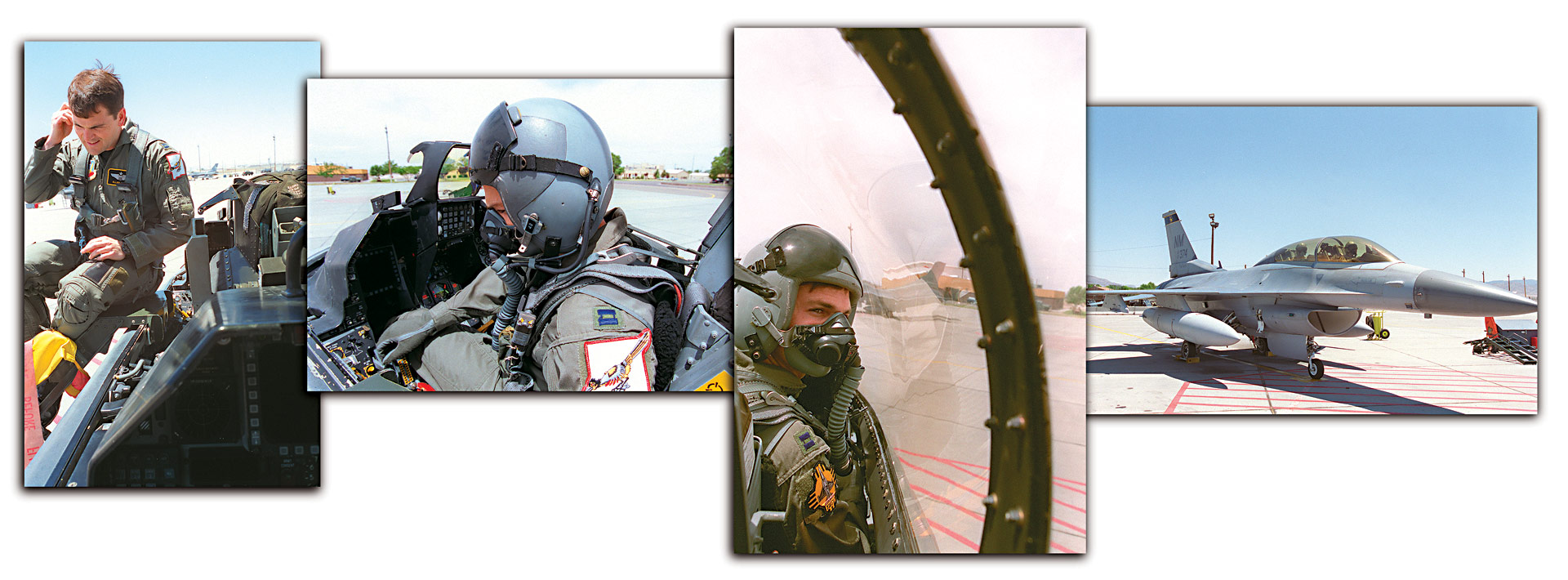
CLIMBING IN ON THE FLIGHT LINE: Allan Gabel prepares the cockpit to fire up the Emergency Power Unit (EPU), one of the most important back up system on the F-16.
AG: So how are you doing back there?
AW: I’m doing great!
AG: Shit Hot!
AW: This is great fun! I’m in awe!
AG: What’s that?
AW: I’m in awe of this whole thing!
AG: Nah, you haven’t seen nothing yet!
AW: [laughs] What kind of wind restrictions do you have on flying the F-16?
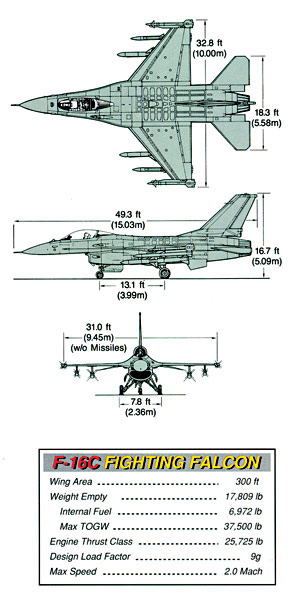
AG: For safety purposes we are not permitted to fly in more than 35 knots of wind. In case, you have to eject you probably wouldn’t survive the landing if the winds were higher than that.
AW: So you stop flying and go windsurfing?
AG: You got that right!
GROUND CONTROL: Taco 4 zero cross runway one seven turn right and taxi on Charlie and follow South West Boeing 7 thirty 7 taxi runway one 7.
AG: 4 zero crossing one 7.
[Pilot switches frequency from Ground Control to Control Tower]
TOWER: …Morning zero 2 victor.
AG: Tower Taco 4 zero is ready in turn requesting unrestricted to 16 five.
TOWER: Flight 4 zero, Albuquerque tower, roger hold short of runway one7 on request.
AG: Holding short, 4 zero.
AG: You always get these little kids on the fence who always like to wave at you.
AW: That’s great! [Chuckles]
AG: Ok John, no turning back now!
AW: Oh boy, I’m having second thoughts! I don’t know about this!
AG: [laughs]
TOWER: Taco Four zero, runway one 7, taxi into position and hold. Delta 7 thirty 7 on a ten mile final and Uh, you have South West in sight?
AG: AeeFirm. On to hold.
TOWER: Taco Four zero maintain your separation with South West 7 thirty 7, fly heading one nine zero unrestricted climb to one six thousand is approved maintain one 6 thousand.
AG: Cleared for takeoff one 9 zero Taco 4 zero
AG: Ok! Arm your [ejection] seat. Take the handle, put it in the armed position.
AW: Roger, seat armed.
AG: Mine is armed, yours is armed. Okay do a little run-up, check the engine, everything still looks good and we’re off.
AW: All right! [Plane starts moving down runway.]
AG: Here’s mil [military] power, here’s the afterburner, feel it kicking in?
AW: Yea haah…man that is power!
AG: Here’s 100 knots, at 150 we rotate and take off.
AG: There’s the gear going up!
AW: Woooo!
AG: Ahh, get a little speed here…Ok, there’s 2 and a half Gs, we’ll keep it down to that!
[Pulls up to a steep climb (55 degrees nose high)]
AG: Quite the roller coaster huh?
AW: Did you roll the plane upside down when you leveled off to avoid negative Gs?
AG: Yep!… Departure Taco 4 zero level at 16 thousand.

DEPARTURE TOWER: Taco four zero have you on radar contact, haven’t found your transponder yet. You want to cancel with me or you want to talk to the center.
AG: I like to cancel with you on a 3 zero zero heading.
DEPARTURE TOWER: Are you going to stay at 16 five?
AG: AeeFirm
DEPARTURE TOWER: Taco 4 zero flight cancellation received, and huh, proceed on course.
AG: 4 zero Thanks!
AW: Are we still on afterburner?
AG: Noo, we’ve been back on a nice cruise power so we can have enough gas to go where we’re going. That afterburner uses up quite a bit.
AW: I’m absolutely speechless. Tell me how much fuel this baby swallows.
AG: Well normal cruise we burn 3,000 lbs an hour. That sounds like a lot but that’s in pounds so that’s 500 gallons an hour. When you use the afterburner it goes from 3,000 to 50,000 an hour. At that rate, you’ve got 11 minutes of fuel.
AW: Wow! You mean if afterburner stays on, this flight will last only 11 minutes?
AG: That’s right!
AW: Tell me a little more about the F-16.
AG: Well, it’s pure sex.
[Both laugh]
AG: The Air Force calls the F-16 the “Fighting Falcon” but to pilots who fly it, it’s a viper.
AW: Why viper?
AG: It’s sleek, fast, agile and deadly. It was intended to be a multi-role fighter and it has fulfilled that requirement beautifully. Tell you what, we’re going to be switching frequencies here in a moment so we won’t have this guy talking in our ears.
DEPARTURE CONTROL: Taco 4 zero your cancellation is received. Maintain VFR altitude at your discretion, and huh radar service is terminated, squawk one two zero zero, frequency change approved.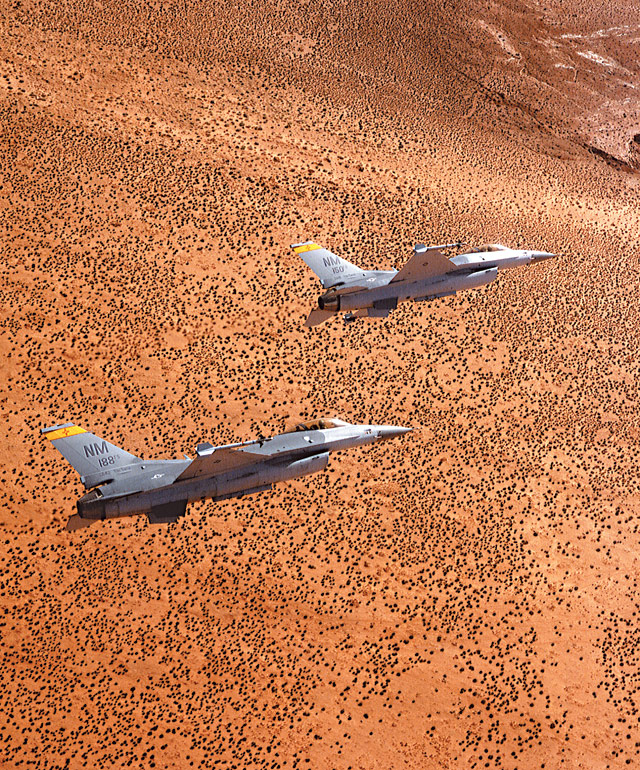
AG: Taco 4 zero Thanks. Adios.
AG: He won’t be bothering us anymore.
AW: Now where are we flying to?
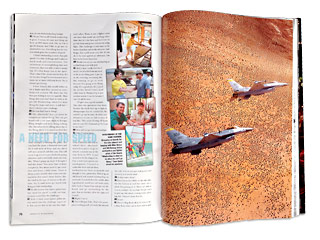
AG: Right now we are flying to Ship Rock, where four corners of four states come together. About ten minutes after that we’ll hit Monument Valley and then a few minutes past that we’ll be at Lake Powell.
AW: Have you windsurfed there?
AG: I fly over it all the time but I‘ve never had the opportunity to spend any time at the lake itself.
AW: Is that a windy lake?
AG: Well, I kinda doubt it. You might get some funneled wind through there, but it sits low in some channels, so I think it would be pretty much protected. I’ve never heard of anybody going there to go windsurfing.
AW: So in Albuquerque, where do you go windsurfing?
AG: I’ve been to Cochiti Lake about an hour away. I mostly go to Elephant Butte which is to the south, two hours. It is a very large lake, the largest in New Mexico. There’s a couple of other very pretty lakes, Conchas, Heron, El Vado and Abiquiu, spread throughout the State. The really good one for the winter is Morgan Lake up by Farmington. It’s a power plant cooling pond, so you can be out there in a light wetsuit in a blizzard and windsurf just fine ‘cause the water is 80 degrees. Quite the deal. The biggest windswept hot tub in the country, I’m sure.
AW: Were you windsurfing before you got into the guard and learned to fly?
AG: Oh yeah. I’ve been windsurfing on and off for about 16 years now. Still not good at it, but that’s another story.
AW: I hope you’re good at flying.
AG: [laughs] I like to think so.
AW: Tell me how you got into flying.
AG: Well I’d been doing general aviation ever since my first year in college and always drooled over the idea of flying jets for the Air Force. And every time I went to talk with the recruiters they wanted too many years of my life. I just couldn’t do it and I found out from a friend of mine when I was in grad school, that the Guard trained pilots and they only need two years of your life to go through all the training. You can then become a part timer and go back to whatever you were doing full time and just fly jets on weekends and a few other times a month. I thought that was a really good deal and started looking around and talking to a few people. I was just in the right place at the right time to get a job here with the Tacos which was near my grad school in Tucson.
AW: But you’re full time now with the Guard and doing exactly what you didn’t intend to do with the Air Force! What had changed?
AG: Well originally I wanted to go into the space program so I earned a PHD in optical sciences for that reason. But the demise of the SDI (Strategic Defense Initiative) “Star Wars” made it difficult to get a job for several years. By then I realized that I would rather be flying than working inside a lab, and the flying was an alternative way to get into the space program anyway. I had intended to be a scientist who flew jets, now the emphasis is I’m a pilot who has a scientific background. I had intended to be a Missions Specialist now I am more qualified to apply as a Shuttle pilot.
AW: I always thought pilots in the National Guard were part-time airline pilots.
AG: That’s mostly true, most people are part timers, and generally fly airlines. But I’m one of the few full timers. I had to wait several years to get that position ‘cause they are coveted and few and far between. I was a part-timer for three years without having another job, then a full-time position opened up for which I was hired.
AW: Tell me your job description. I mean you just don’t come out and fly all day long do you?
AG: Well my primary job and purpose is in fact to fly and stay proficient in the airplane, ready to go to war or whatever that is required of me, but all pilots have additional duties and my additional duties include maintaining of the all the computers and software in the squadron. There is always paperwork, ground training, and flight planning to be done and now I take care of getting flight clearances for our test work if we need to carry a new pod they haven’t cleared before…so mostly paperwork.
AW: You were called to Bosnia, right?

AG: Yeah, I ended up flying with a squadron over in Aviano, Italy that was doing the night flight and delivering force over in Bosnia. I did end up involved in that action along with several other of our pilots in our unit. We did not deploy over there as a unit, but at some point, it is very likely we will end up over there for a couple months to relieve the squadrons that are there.
NIGHTLINE ACTION IN BOSNIA: The dream of every pilot rode in the seat of Gabel’s Bosnia bombing tour. Joining the 510th Fighter Squadron in Aviano, Italy shortly after the downing and rescue of Capt. Scott O’Grady, Gabel caught the TV lenses of Nightline and was celebrated by the New Mexico media.
This aircraft with all its capabilities makes us very much front line equipment. Everything these days is done with precision guided weapons to minimize collateral damage and there are very few aircraft that can deliver those weapons. This is one of them. We are the only unit in the Air National Guard that has the Block 40 F-16, which has fully independent night attack laser guided weapon capability.
AW: So after flying an airplane like this and dropping bombs in a life and death situation, do you find windsurfing boring?
AG: Oh no! Not at all! I think windsurfing is great. I mean, it’s sure not flying up here at 600 knots and, Ok, so I’m a speed demon, but I like to go fast on windsurfers too. Everything has its context which gives the sensation of speed.
I think windsurfing is more than just speed, it’s a fun challenge and it takes so much work and concentration. The excitement of accomplishing that new maneuver, that new skill, is what’s satisfying. It’s what keeps you in the sport. That’s what I like about windsurfing. It’s the hardest thing I’ve ever learned and it exists on so many different levels. No, it doesn’t get boring.
I have friends that would rather sit on a Seadoo and drive around on something with a motor. Ok, that’s fun, but that gets boring to me very quickly. Most things that you don’t have to work at do get old. Windsurfing, which I’ve been doing for years and years, is still fun—there’s always a new challenge.
AW: Do you find that in flying?
AG: Oh, absolutely! You can never be complacent about flying. You can get bored with a ten hour flight to Europe, flying straight and level, doing nothing else, but when we’re talking about day to day flying, there is so much involved that you have to stay proficient with. The most basic example is landing the plane. You can land the plane a thousand times and do it well most of those and one day it will turn around and bite you. You will screw it up if you’re not absolutely paying attention and it will really make you wonder, “What’s going on here? I thought I had this down.” You never have it down completely. You always need to pay attention and learn a little more. There is always a new variable that comes into the equation that wasn’t there before, like the wind or the type of runway or the altitude. No, I could never get bored with flying or with windsurfing.
AW: So this notion that fighter pilots have this “need for speed” is really not true, it’s more a need for the challenge?
AG: Yeah, I think most fighter pilots are very much into the challenge aspect of it. You can see that in the way they fight each other. There is not a fighter pilot out there that would say anything other than that he’s the best and he’d love to go out there and prove it to you in a dog fight. The challenge is you want to be better than him and in the ultimate challenge, this could mean your life. If you do it for real against an adversary, you have to be better than him.
AW: Would you say you use windsurfing as a relief from your daily job?
AG: Well, I don’t really feel that I need a lot of relief from my work as far as my flying goes. I get up in the morning not hating life, but wanting to go to work because I’m going to be flying today. It’s a good job, it’s a good life, it’s fun. Relief? I don’t need relief from it. Windsurfing is just another activity I can do because I can’t fly all the time.
I’ll give you a good example. The other day operations shut down because the winds blew up so high in Albuquerque that we couldn’t fly. We couldn’t go up because of safety considerations in case we had to eject. It was like, “The winds blowing 40 knots and we can’t fly? Outstanding! Let’s go to the lake!”
AW: How did you get into windsurfing?
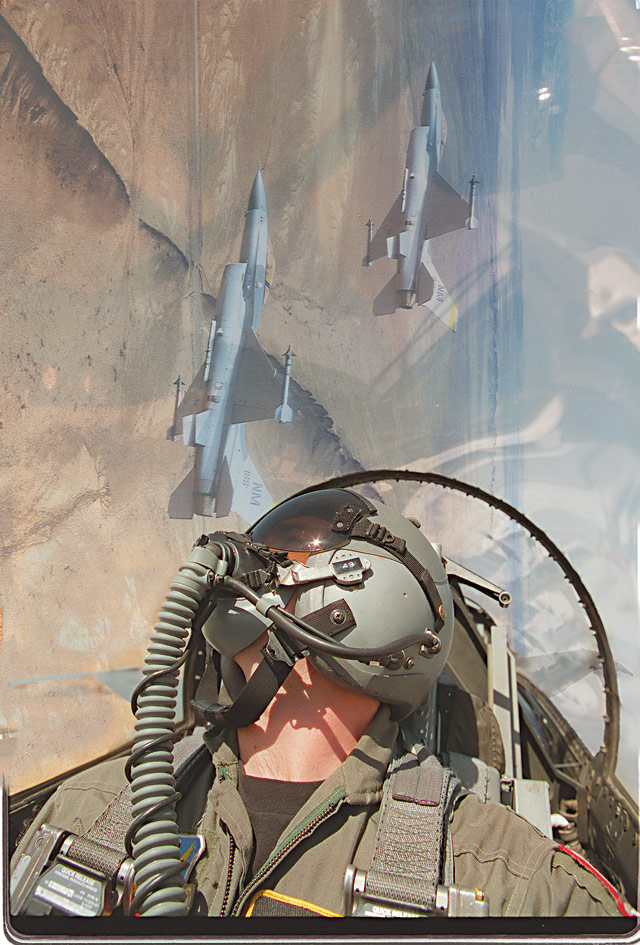
AG: Ahh, I lived in Santa Cruz, California and went to school there…absolutely marvelous place to go to school, certainly was at the time back in 1979. It just seemed to be the thing to do. I’m a real watersports oriented person. I learned to scuba dive there and saw these windsurfers out there occasionally and thought it was a great idea. Picked up an old board and started windsurfing on weekends. I worked there for awhile after I graduated, would get off work early, drive back to Santa Cruz and get out the board and go windsurfing by the pier…You see this lake off to the right at 2 o’clock?
So at 61% we’re going at 320 indicated air speed, which is around 450 true air speed…so, gosh! If you go Mach 2, which is what this plane is capable of, you can go way over 1200 mph!
AW: Right? I see it.
AG: That’s Morgan Lake. That’s the powerplant cooling pond…it’s really flat around the side of it so you get real good wind across it, real steady wind.
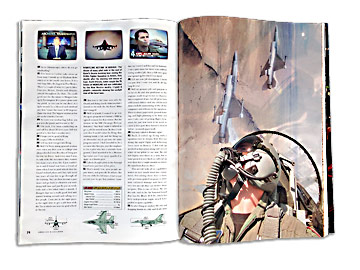
AW: Is that water clean?
AG: It is, I mean it’s a little on the silty side, but the bottom is real fine sand, not a whole lot growing in it. There are fish in it so it couldn’t be too bad. People used to give me shit about coming home glowing, but I haven’t done that yet.
AW: [laugh]
AG: There’s Ship Rock off at 11 o’clock. It’s a three-hour drive out to here and we just got here in about 21 minutes and were flying as slow and carefully as we can.
AW: Wait till I take the controls! So the speed of sound is what? Five hundred and something?
AG: Well it varies with altitude, right now if you look at the HUD [Heads Up Display] there at the lower left corner, it says SIM and right underneath that it says .61. That is what we are doing, .61 mach, so 61% the speed of sound.
AW: So at 61% we’re going at 320 indicated air speed, which is around 450 true air speed…so, gosh! If you go Mach 2, which is what this plane is capable of, you can go way over 12 hundred mph!
AG: Yeah, mach 2 will be pushing about 12 to 14 hundred miles a hour…but again that changes with altitude. As you go higher, the mach value is a slower true speed. At sea level, red line is 800 knots.
AW: What’s it like to break the sound barrier?
AG: It’s actually surprisingly ho-hum. The airplane just accelerates, you see a little fluctuation in your altimeter and you’re going a lot faster than you were a minute ago. The plane is just as maneuverable, although to try to turn the plane at those speeds you’re going to pull some serious G’s.
AW: Have you ever gone to mach 2?
AG: No, I’ve gone up to 1.6 before. Mach 2 you can only do if the airplane is absolutely clean, meaning there is nothing hanging on the wings, no fuel tanks, no bombs, nothing at all. We rarely fly a plane configured that way, ‘cause there’s no reason to. Later on we’ll try to enter a military air space and go supersonic.
AW: Cool! . . . You must get to windsurf in many parts of the world as you get deployed on different missions.
AG: There are definite opportunities. A month ago I had a flight planning conference at Eglin Air Force base in Florida, that’s right next door to Ft. Walton Beach. Not real windy, but steady, so I managed to get a few days of real good sailing in there. I went out to Hawaii to do some tests for the army and ended up staying a month ‘cause their test got extended. I had quite a bit of opportunity to windsurf but unfortunately there was little wind. We got 2 or 3 days of wind the whole time I was there. I just happened to be in Maui, imagine that, and got in some good days of windsurfing thanks to my friends out there.
Sketch of a Block 40 LANTIRN F-16 fully armed with heat seeking missiles, radar guided missiles and laser guided bombs.
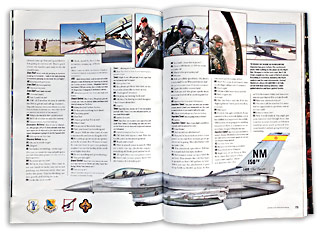
When I was in Italy, I got to see Lake Garda. No wind that day, but I got to see the place. The opportunities are there. It’s a really good life to have a job that takes you all over the place but still allows you to live in one place if you choose to.
AW: Boy, there’s greenery down there!
AG: Yeah, we’re crossing over a mountain ridge here and into Arizona. Four Corners is right there, real close to us, we’ll cross into Utah shortly thereafter.
AW: You must see some spectacular sights from up here.
AG: Oh yeah! We take airplanes to Hill Air Force Base up in Salt Lake City for example. I do that quite a bit, there is a depot up there where they get repaired and painted. So we are constantly swapping out airplanes up there. That’s one of my favorite trips. There is so much to see between Albuquerque and Salt Lake it’s incredible. The most exotic landscapes I’ve seen in this country are in that area. And all these different National Parks, even though we stay up above them to keep from buzzing anybody. That, of course would be illegal. You’ve got Arches National Monument, Bryce Canyon, Zion Canyon and Canyon Lands, Monument Valley, Lake Powell and it just goes on and on. It’s just incredible…and you see all of it in a hour and a half.
AW: You know, I just noticed that the leading edge of the wing goes up and down automatically.
Whenever you’re flying at a very low air speed at a very high angle of attack, the airplane understands it and the computer calculates a bunch of stuff and essentially reconfigures the wing for an optimum lift versus drag ratio.
AG: The flaps and slats of this airplane are all automatic. Whenever you throw the gear down the flaps come down with them. Whenever you’re flying at a very low air speed at a very high angle of attack, the airplane understands it and the computer calculates a bunch of stuff and essentially reconfigures the wing for an optimum lift versus drag ratio. Right now we are flying right at an edge of a point where it wants to start using the flaps. If you’re flying very fast everything would just be streamlined and it wouldn’t care. Minimum lift required. But yeah, you’re seeing them automatically operating back there. If we were to pull some G’s and try to get slow, you’d see all that stuff come down and change the camber of the wing…Ahh, we’re coming up to Monument Valley!
AW: Wow that’s incredible!
AG: Yeah you see the two mittens here?
AW: Wow!
AG: It may be desolate land but it’s really impressive…let’s fly around a bit.
AW: These G-suits are pretty effective. As soon as a little G comes on it pumps up.
AG: Have you tried the test button in the back?
AW: No.
AG: Ok, on the left side, in the back…
AW: Yea I see it…Wooo!
AG: Push it real gently a couple times and it will pump up. If you just let it pump all the way up you’ll think it’s going to crush you. It’s pretty aggressive. But if you’re actually pulling G’s and it has to inflate like that, you won’t even notice it because you’ll be straining so much.
What’s really impressive is the new G-suits we have called “Combat Edge” which is not just from the waist down like these, but it’s a full vest and covers you from the neck down. Now the first question is how do you breathe? Well part of the system includes pressure breathing as well. Your mask will take over pressure to compensate for the pressure in the G-suit. So you hardly even notice the pressure but it’s actually squeezing your body real good to keep the blood from rushing down to your feet.
AW: Now the idea is to keep as much blood in your head as possible, right?
AG: That’s right, ‘cause that’s how you black out. If you can squeeze real hard and keep the pressure above zero, you’re doing fine.
AG: Okay, we’re starting to see a little more traffic up ahead which is kinda expected cause we’re getting near Lake Powell…you’re warm enough back there?
AW: Yep!
AG: If you get too chilly you can always turn off one of those valves, that would help a little bit.
AW: Is that Lake Powell up ahead?
AG: This is one of the fingers off of it. We’ll just work our way into the lake.
[Caution] [Caution] [Caution]
AG: Ah, let’s see what we’ve got for master caution…
[Caution] [Caution] [Sexy female voice coming out of the plane]
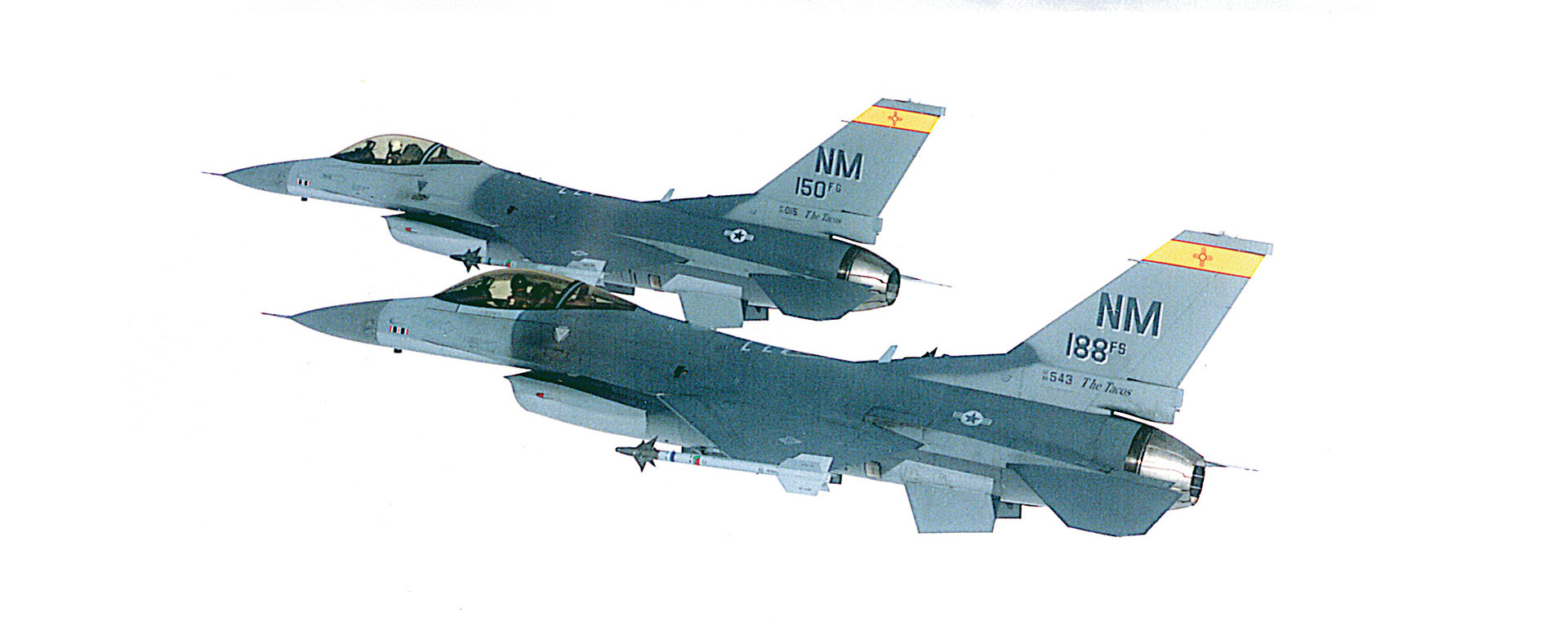
AG: Well it says our radar failed…it seems to be still working…Now is when we have to be careful cause you run into bug smashers down here.
AW: Are you referring to birds?
AG: No, those are little airplanes, Cessnas and such.
AW: [laughs]
AG: Yeah, you can see how the water is down in the canyons here?
AW: Is this a river?
AG: The lake itself is just a river, it just gets wider and wider and has all the different off shoots and S-turns…
AW: Little whitecaps down there!
AG: Oh yeah! In the channel, venturi point.
AW: Boy, there’s all kinds of nooks and crannies here.
AG: It’s incredible. You can get lost so fast. Now and then you’ll see somebody way back in one of those nooks in a house boat. You can go back into one of those places and homestead it. Kinda make claim to the land for a few days. Certainly enough room. I’ve heard of some pretty wild parties in some of those nooks.
AW: I’ll bet!
AG: There is actually an arch in here somewhere, one of the offshoots over here, let see if we can find it…
AG: I believe it’s this one… yeah there it is. Ok left 10 o’clock low, look straight at the mountains, you’ll see an offshoot here with an arch in the back.
AW: Yeah, I see it. Cool! Incredible!
AG: Lets see, we’ve had the tape running for 45 minutes… actually pushing an hour. So as soon as we’re done with the lake we’ll shut it off for the trip down to the Elephant Butte.
[Pilot turns off three sets of 90 minute 8mm tape that are recording our conversation, the HUD display and the radar. 20 minutes later tape is turned back and control of the plane is passed to me]
AG: Ok the tape is rolling and I’m going to let you fly her…Ok, you’ve got the jet.
AW: Ok, I got the jet…what am I suppose to do with it? [laughs]
AG: [laughs] Whatever you want. You can probably leave the throttle where it is. Grab the stick, roll it back and forth, see how sensitive it is.
AW: Wow!
AG: Yeah, you really don’t need to use the rudder in this airplane unless you’re doing some wild maneuver. Just roll it, pull it, see how many G’s you want to pull…there’s something interesting we should go look at over here at 10 o’clock.
AW: This control system, is it what they call “fly by wire”?
AG: Yes it is exactly fly by wire…now if you come left 40 degrees…yep roll it over…see these little white dots out here on the desert?
AW: Yes?
AG: These are a large array of huge telescope dishes that are on a 30 mile railroad track in three directions. And they will send those things out or bring them in according to how they want to focus the telescope. Essentially it’s one big telescope. Kind of a wild thing out in the middle of the desert…We’ll come back this way to do some acrobatics.
AW: So explain to me what exactly “fly by wire” means.
AG: Well, it just means you are not actually moving the control surfaces. You’re putting in an input of a pressure on a stick and the computer senses it with electrical switches and says, “Ok, I think this pilot wants us to turn left.” “Ok, well how are we going to do that?” You know you’ve got several computers in here. So they agree “I guess if we move the surfaces this way or that way it will go where he wants it to go.” So you are not actually doing it, it’s the computer that’s doing the flying. You’re just putting in your request and the computer will determine how it’s going to get there. So you’re completely isolated from the control surfaces unlike those in a little bug smasher where you’re tied directly with cables to make them move.
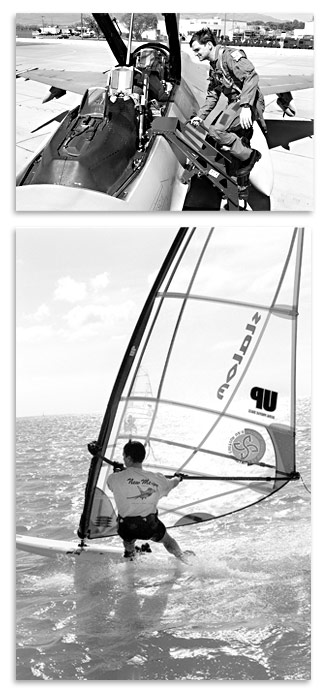
AW: What altitude do you want me at?
AG: 17 five, right about here.
AG: Ok, you were asking me how we travel around and where we store our luggage. We have these pods which are basically old napalm canisters that we put a little door on and they can hold quite a bit. You know, a set of golf clubs, a little bit of luggage, whatever you need for a nice TDY. Last time I was in Hawaii back in January, I bought a few sails and had them stuck in the pod on the way home.
FLYING FOR WORK AND PLEASURE: Gabel’s need for challenge is satisfied by flying in the air and on the water. A techno junkie, Gabel’s wings of steel and wings of plastic are never far apart.
AW: That’s great!
AG: Ok, I got the jet.
AW: You’ve got the jet
AG: I’m going to bring us down a little bit.
AW: What’s the name of this town?
AG: That’s Truth or Consequences, and this is Elephant Butte Lake.
AW: I’ve heard of that town.
AG: My friend Jim lives in one of these houses and let’s see if he’s home…no Jim’s not home.
AW: You can tell by the car?
AG: Yeah.
AW: Hey there’s whitecaps down there on the lake man!
AG: Yeah there’s a little bit… that’s sailable!
AW: Definitely. That’s a 6.5 day!
[Plane turns around and heads north over the lake]
AG: Hopefully it will pick up in the next couple of days. Of course it’s going to be really crowded this weekend.
AW: Wow, there’s a lot of wind down there.
AG: Yeah. This entire shoreline will be covered wall to wall with campers. Oh yeah! This is perfectly sailable! Check-that-out!
AW: Excellent!
AG: This is our favorite spot right here. They’re already filling in for the weekend. This looks pretty good! Pretty darn good!
AW: Oh this is an excellent place to sail! Wow ! 4.5!
AG: Yeah check out there in the middle of the wind channel!
AW: Wow! Flat water on one side and waves on the other.
AG: That’s the thing. Down south it doesn’t look very good ‘cause you don’t have much of the waves building yet. But at this end even if the wind is light, the waves have the entire length of the lake to build. If you want waves you come to this end.
AW: That’s beautiful.
AG: Ok, let’s climb back up and see if we can’t take you supersonic here…
AG: Cherokee, Taco 4 zero.
MILITARY SPACE CONTROL: Taco 4 zero, go ahead.
AG: Taco 4 zero is about 10 miles north of Truth or Consequences, like to know if I can steal 5 minutes of Lava West time?
MILITARY SPACE CONTROL: Taco, huh, unable, that airspace is mainly used at this time.
AG: Okay, thanks.
AW: So nix on that?
AG: Yeah, he told me no. Let me ask him one more time, see if I can get him.
AG: Cherokee, Taco 4 zero.
MILITARY SPACE CONTROL: Taco 4 zero go ahead.
AG: Any chance that the airspace will open up in the next ten minutes?
MILITARY SPACE CONTROL: Standby 40 zero… Taco 4 zero, I show that airspace opening up at huh…5 zero after the hour.
AG: OK thanks.
AG: Nope! Nix on that…Alright…
MILITARY SPACE CONTROL: Taco 4 zero, huh disregard that sir, that’s my mistake. I show that airspace being used for the next hour and a half.
AG: OK, that will work, thanks.
AG: Let’s see if we can head back to CATO MOA and get some airspace over there.
AW: Now explain to me what happened.
AG: What happened is this airspace to the right…wait, see that circle on the ground at 3 o’clock?
AW: Yep…
AG: That’s where they set off the first nuke. Trinity Site.
AW: Wow! And that’s Roswell over there!
AG: This whole area to the east of the river here is White Sands Missile Range Air Space training and, it is restricted airspace. This is where we do a lot of our combat training and you can go supersonic in there. I just asked him if it was available so that I could jump in there for a few minutes and do something and he said: “Nope sorry. There’s other people in there using it right now.” Basically I don’t think he tried, so be it, can’t argue with him too much…
AW: That’s too bad.
AG: So what we’re going to do…there’s this other airspace over here and huh, we’re going to see if we can…[BINGO] [BINGO]
[sexy female voice again]
AG: Bingo, running out of gas here, ok we don’t have too much gas left.
AW: Bingo means that the gas is low?
AG: It’s telling me that’s where I’ve set the fuel low level warning to come on. So I’m going to set it down to a lower level.
AG: Ok, let’s see….
AG: Albuquerque center Taco 4 zero.
MILITARY SPACE CONTROL: Taco 4 zero Albuquerque.
AG: Taco 4 zero is about 10 miles to the south of Socorro, request clearance into Cato for about 10 minutes.
FLIGHT CONTROL CENTER: The call sign is 1 zero?
AG: Taco 4 zero.
FLIGHT CONTROL CENTER: Taco 4 zero, roger, squawk 2634…this will take a few minutes for coordination.
AG: Squawking 2634 Taco 4 zero.
FLIGHT CONTROL CENTER: Want the whole thing?
AG: Ahh negative. I just need up to 18 thousand please.
FLIGHT CONTROL CENTER: One moment.
FLIGHT CONTROL CENTER: Taco 4 zero cleared into Cato maintain 13 five to 1 eight zero. You can change pattern, call me back when you’re clear to come out.
AG: Ok Taco 4 zero clear from 13 five to 18 and we will call you back when we’re done. Thanks!
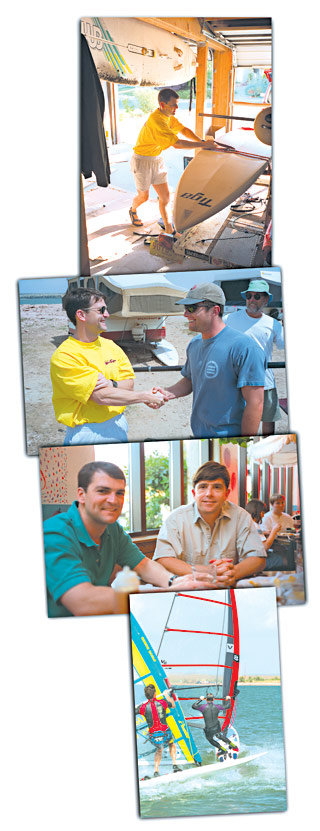
AW: So they cleared us?
WITH FRIENDS OF THE SAME FEATHER: Strapping on boards for the lake (above) and hanging with Mike Holzer and Bill Rodway fellow windsurfers and fighter pilots of the Guard. “Windsurfing is what we do when we can’t go flying.” Says Gabel about his passions.
AG: We’re cleared, what that really does for us is that we now own the military operation area and we can do whatever we want inside there. Loops, rolls anything you want to do is fair game. But again we are restricted to 18 thousand for your physiology and 13 thousand five hundred for the bottom of the area. So it’s kind of a narrow range but we can still have some fun in there.
AW: So we can go supersonic here?
AG: Afraid not, but we can play with the jet all we need. So you have the jet.
AW: Ok I’ve got the jet!
AG: We’re right at 18 thousand so we need to make sure we go down if anywhere… Alright! Push the power up aaand we’ve got about a thousand pounds of gas to do with what we want.
AW: What should we do?
AG: Well, let’s see 13 five, you can do a loop, but you’d have to pull pretty hard. You can start with an aileron roll. How about an aileron roll?
AW: So what do I do physically here?
AG: What I would suggest is to bring the nose so that the flight path marker is just above the horizon a few degrees and you just take the stick and push it to one side and let it roll all the way through.
AW: OK.
AG: Just like that.
AW: Wheee! [plane rolls]
AG: Now you see how it got into a dive there? Bring it back up…You might want to start with the nose up a little higher. Now since you rolled right you need to roll left, ’cause you wrap it up and now you need to unwrap it… There you go.
AW: Does it matter how fast I do it?
AG: Nope, you can do it as fast as you like.
AG: Let’s go down to the bottom of the area just about 700 feet below us. Yeah, we’re kinda narrow here…
AG: Ok pull it up, pull it up, we’re going out the bottom…there you go, perfect…Ok, now we’re right at the bottom. Now you can maybe do almost a loop if you take it up as steep as you want but off in an angle and that way we won’t go right out the top. We’ll pull a lot of G’s to make that happen. Ok, there’s 3 G’s.
[Heavy breathing]
AW: Can I keep going for the loop?
AG: Yeah, you can go all the way around. Just keep pulling. Keep pulling.
AW: Wheeee!
AG: Ok! I’ve got the Jet!
AW: You’ve got the Jet.
AG: Just going a little too high there. That’s it, just keep going this way. We’re really restricted to a narrow range here. Ok! We hit 4 G’s there.
AW: What’s the most G’s you’ve pulled?
AG: Nine.
AW: Wow!
AG: That’s what this airplane will go to. The computer won’t let you go any further than that. Not that I would want to. Personally I find it pretty unpleasant above seven…actually about five to six you have to really start working and above seven it just hurts.
AW: Huh.
AG: OK. You got the jet. We’re back at the bottom of the area.
AW: I got the jet. Now what did I do wrong last time?
AG: It was just too slow and gentle. If you’re going to make it in between the parameters of the area you have to do it quickly and make it a tight turn…let me demo one.
AW: OK.
AG: Let’s get it down to 13 five. There’s 13 five. Go to full power, we’ll pull up about 45 degrees up to the side, up to about 4 Gs. Let’s see if we can get it all the way over without hitting 18. Yeah, we’re hitting about 17 five. Yeap, there’s 18. Weee right there. Now we’re doing only 200 knots. Roll out so we won’t hit the bottom. Okay
AW: Four G’s Huh.
AG: Four G’s. See it’s not so bad is it?
AW: Noo…?
AG: Yeah, that’s probably about it for pulling G’s in here, so let’s head back.
AW: Roger!
AG: Albuquerque Taco 4 zero
ATTC: Aircraft calling center say again.
AG: Center, Taco 4 zero calling flight center.
ATTC: Taco 4 zero go ahead sir.
AG: Taco 4 zero is done with Cato we’re RTB at 15 five, VFR, negative flight following.
ATTC: Taco 4 zero roger, squawk 1200, frequency change approved, good day.
AG: Thank you much 4 zero.
[Pilot turns on ATIS for automated report of airport conditions]
ATIS: Albuquerque International approach information hotel, 1 niner five six zulu weather. Clear below 13 thousand, visibility greater than 10. Temperature 8 zero, dew point 2 zero. Wind 1 niner zero. 1 three gust 1 eight altimeter 2 niner 8 zero. Expect visual approach departing and landing on 1 seven. On initial contact advise you have ATIS information hotel.
AW: You got all that?
AG: Yep got that.
AG: Ops Taco 4 zero.
OPERATIONS: Go ahead 4 zero.
AG: 4 zero is 10 out, code one.
OPERATIONS: Ops copy.
AG: Ahh we’re going a little faster now. We’ll just cruise home. We got a little extra gas so we can cruise back quickly.
AW: If you we were to break the sound barrier what would be the procedure here?
AG: If I accidentally did it?
AW: No, I mean the procedure.
AG: Oh, there is no proceedure, you just throw the engine into afterburner and it will accelerate and it will keep accelerating until you pull it out or you run out of gas. Whatever happens first.
AW: Can we try the afterburner?
AG: Ok, here’s the afterburner.
AW: Man! What a kick! That’s acceleration!
AG: We’re up to .97 mach. Too bad we can’t punch through here.
AW: Wow, is that instant speed or what?
AG: It’s pretty amazing, now coming out of afterburner…
AW: You’ve got airbrakes on now?
AG: No, that’s just the drag on the plane without the engine power.
AW: Wow! That’s amazing how much drag you feel on a sleek plane like this.
AG: Approach Taco 4 zero.
APPROACH CONTROL: Taco four zero, Albuquerque approach.
AG: Taco 4 zero is 46 miles to the southwest single for the overhead with hotel.
APPROACH CONTROL: Taco 4 zero squawk 0420 indent.
AG: 4 zero squawking.
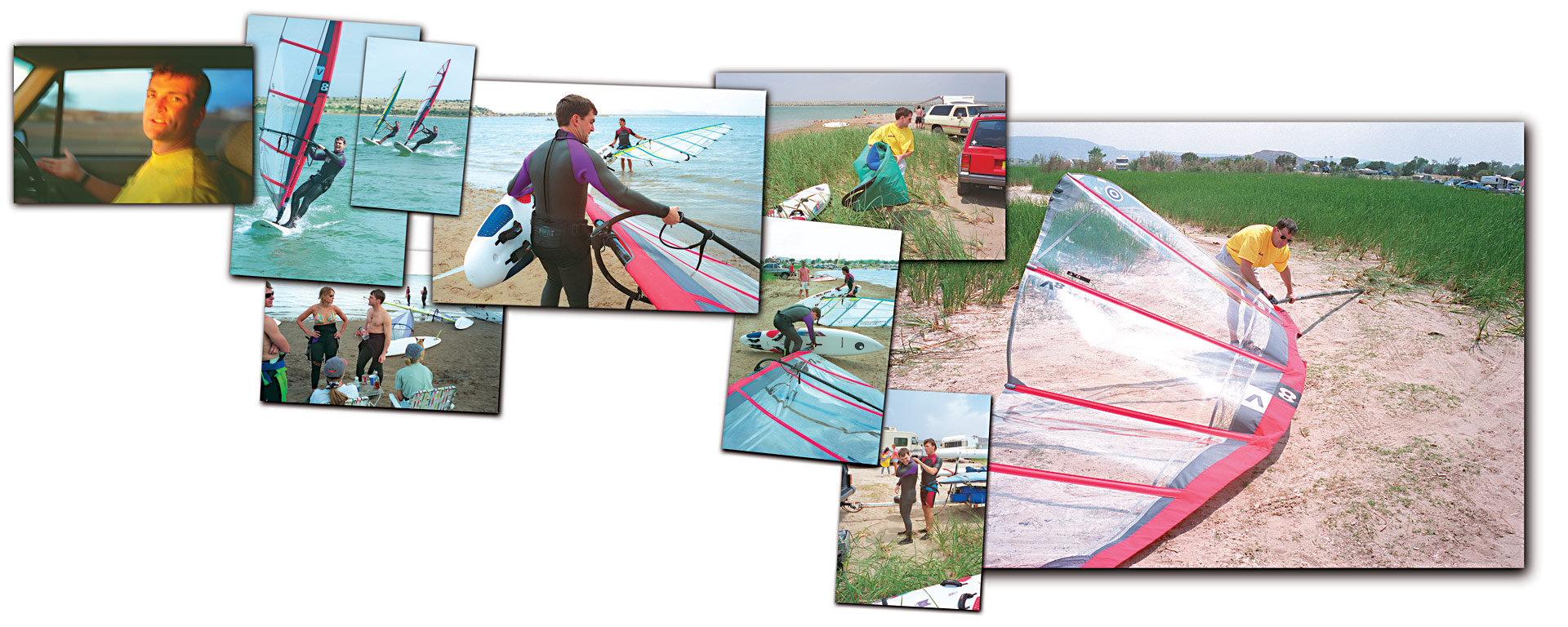
A LOW-TECH DAY: From burning 50,000 lbs of jet fuel an hour on afterburners Gabel recreates with nature on a 7.2 Neil Pryde sail that burns 0 gallons an hour. Boardhead friends such as Joe Lundstrom provide the same sense of camraderie as found in the inner circle of the fighter pilot’s lounge. (far right) The thrill of the sport glows like the setting sun during the two hour drive home from Conchas, a rare New Mexico lake.
APPROACH CONTROL: Taco 4 zero contact one three mile northwest of Soccorro, turn 3-five zero, maintain VFR.
AG: 4 zero to 3-five zero.
APPROACH CONTROL: Taco 4 zero descend and maintain 8 thousand five hundred.
AG: 4 zero down to 8 point 5, field in sight.
APPROACH CONTROL: Taco 4 zero cleared direct initial runway one 7, 7 thousand 5 hundred, expect right break.
AG: Direct initial, 7 point 5, Taco 4 zero.
APPROACH CONTROL: Contact tower on 3-five one point 9 good day.
AG: 4 zero, cleared to land.
AG: Here comes the gear and we’ll be landing at about 160 knots.
[perfect landing]
AW: Nice landing! You’ve done this before?
AG: Yeah, just a few times. [laughs]. So what da ya think…
AW: I think it’s time to go windsurfing!



